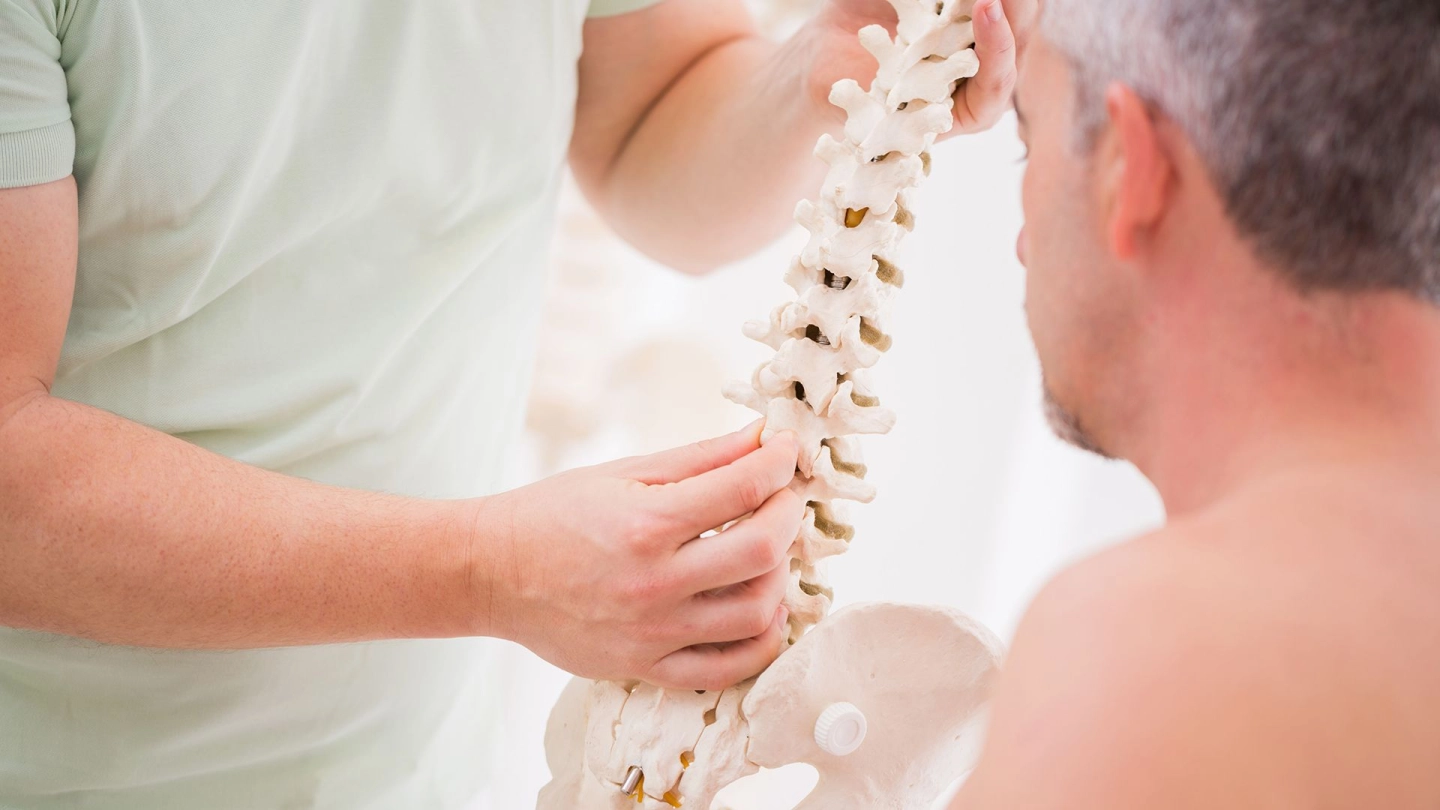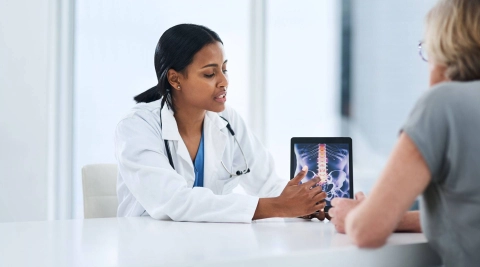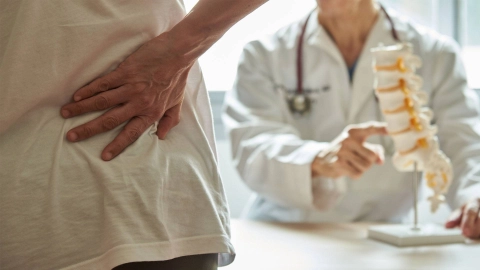Conditions Slipped (herniated) disc
ICD codes: M50 What are ICD codes?
A slipped disc can go unnoticed, but also cause severe discomfort. The pain usually goes away within six weeks.
At a glance
- Early signs of a slipped disc can be severe pain radiating down one leg and into the feet.
- A slipped disc can also cause numbness or pins and needles.
- These symptoms usually go away on their own after a few weeks.
- Until then, it helps to treat the pain and remain as active as possible.
Note: The information in this article cannot and should not replace a medical consultation and must not be used for self-diagnosis or treatment.

What is a slipped disc?
Almost everyone is familiar with back pain, but usually it is hard to say what the exact cause is. But if you have pain that radiates down the leg and into the foot, it may be a sign of a slipped spinal disc, or “herniated disc”. Most people find that the pain goes away within six weeks.
The spinal discs sit between the vertebral bodies of the vertebrae. They consist of a gel-like center (nucleus pulposus) surrounded by an elastic casing made of cartilage.
A slipped disc occurs if the spinal disc tissue pushes out, or “herniates”, between the vertebrae. This herniated tissue may irritate the neighboring spinal nerves and cause severe discomfort. But not every disc is painful.
Video What is a slipped disc?
The video below explains more about the causes of a slipped disc as well as the symptoms and treatment options.
This and other videos can also be found on YouTube
Watch nowThe privacy policy indicated there applies.
What are the symptoms of a slipped disc?
A slipped disc can often cause sudden and severe shooting pain in the lower back. A typical symptom is pain radiating down one leg and into the foot. This is referred to as ischialgia but also commonly known as sciatica. It is mainly caused by slipped discs in the lumbar (lower back) region.
If it occurs in the neck area, the pain might radiate into the arms.
In rare cases, numbness in the buttocks or signs of paralysis may develop and these symptoms are signs of a more serious problem, like nerve damage.
What causes a slipped disc?
Spinal discs act as shock absorbers between the vertebrae in our spine. If a spinal disc is no longer able to bear the strain, it can result in a slipped disc. The associated pain probably arises when part of the spinal disc pushes against a nerve in the spinal cord.
In most people, slipped discs are a result of wear and tear. They are a normal part of the aging process – although they vary from person to person. Over the years, the spinal discs lose their elasticity. Fluid leaks out of them and they become brittle and cracked. Very rarely, an accident or severe injury might also cause damage to a spinal disc.
Many people are particularly familiar with the pain typically associated with sciatica. They are caused when disc tissue presses on a nerve root in the lumbar spine. The nerves that run through the spinal canal connect to the sciatic nerve. The sciatic nerve then runs down the legs. As well as being painful, an irritated sciatic nerve can also cause pins and needles and numbness.
Experts differentiate between three severity levels with regard to a slipped disc:
- Protrusion: the disc bulges out between the vertebrae but its outer layer is still intact.
- Prolapse: there is a tear in the outer layer of the spinal disc causing spinal disc tissue to spill out. However, the tissue that has come out is still connected to the disc.
- Sequestration: the spinal disc tissue has entered the spinal canal and is no longer directly attached to the disc.
Important: Spinal disc prolapses and sequestration cause leg pain more frequently than protrusions. The type of slipped disc can be important with regard to the best form of treatment and how the condition progresses.
How often does a slipped disc occur?
It is estimated that 3 percent of the population will have back pain caused by a slipped disc at some point in their lives. Slipped discs are more common in people over the age of 30, and are about twice as common in men as they are in women.
What is the outlook for people with a slipped disc?
For some people the pain can start very suddenly, and then disappear again by itself very quickly. Some people have permanent pain that lasts a long time, while others have it again and again. A slipped disc can therefore develop in very different ways.
About 90 percent of people with a slipped disc find that the symptoms subside on their own within six weeks. It is believed that the body gets rid of part of the prolapsed tissue or that it shifts position so that the nerves aren't irritated anymore. If the pain persists for longer than this, it is unlikely that it will go away on its own.
How is a slipped disc diagnosed?

Doctors are usually able to make a diagnosis by asking a few questions and performing a physical examination.
There are few good reasons for other complex diagnostic examinations. X-rays are therefore not very suitable because they often show disc damage in people who don’t have any symptoms. Imaging techniques may show a supposed cause of lower back pain that actually has nothing to do with the symptoms. This kind of misdiagnosis can result in unnecessary treatment that may itself be harmful.
Imaging techniques such as magnetic resonance imaging (MRI) are only needed if any of the following occur:
- signs of paralysis in one or both legs
- impaired function of the bladder or bowel
- unbearable pain despite treatment
- back pain does not improve after four weeks or leg pain after two weeks
- another condition is suspected to be causing the pain, for example a tumor
How is a slipped disc treated?
The focus is on providing pain relief treatment that can help people to cope with the symptoms, the aim being to stay as active as possible. But treating the pain doesn't speed up recovery. Even severe sciatic pain can usually go away on its own after a while. Surgery is seldom necessary.
Important: Surgery is required if the nerves are so severely affected that the bladder or the bowel is no longer functioning properly or significant paralysis occurs. Surgery may sometimes also be an option to try to relieve the pressure on the affected nerve, for example if severe sciatic pain caused by a slipped disc lasts longer than six to twelve weeks despite pain relief treatment.
More detailed information about when spinal disc surgery is appropriate can be found at: gesundheitsinformation.de.
Which rehabilitation measures can be of benefit for back pain?
Rehabilitation is an option for people who have been greatly affected by their back pain and are unable to work or perform other everyday activities. Rehabilitation programs can involve back pain training courses, strength training and stretching and relaxation exercises, for example. The aim of the exercises is to improve the symptoms and restrictions, and strengthen the muscles in the torso in order to improve the stability of the spine.
Rehabilitation can also motivate people to regularly exercise during everyday life and help them deal with pain. It is important to regularly perform the exercises for the joints and muscles even once the rehabilitation phase has ended so as to maintain the improvements achieved and prevent further pain in the future.
What are the possible causes of back pain?
The video below presents potential causes, triggers, and symptoms of non-specific and specific low back pain.
This and other videos can also be found on YouTube
Watch nowThe privacy policy indicated there applies.
- Brinjikji W, Luetmer PH, Comstock B et al. Systematic literature review of imaging features of spinal degeneration in asymptomatic populations. AJNR Am J Neuroradiol 2015; 36(4): 811-816. Aufgerufen am 13.06.2023
- Bundesärztekammer (BÄK), Kassenärztliche Bundesvereinigung (KBV), Arbeitsgemeinschaft der Wissenschaftlichen Medizinischen Fachgesellschaften (AWMF). Nationale Versorgungsleitlinie Nicht-spezifischer Kreuzschmerz (in Überarbeitung). AWMF-Registernr.: nvl-007. 2021. Aufgerufen am 13.06.2023
- Czabanka M, Thome C, Ringel F et al. Operative treatment of degenerative diseases of the lumbar spine. Nervenarzt 2018; 89(6): 639-647. Aufgerufen am 13.06.2023
- Deutsche Gesellschaft für Neurologie (DGN). Lumbale Radikulopathie (S2k-Leitlinie). AWMF-Registernr.: 030-058. 2018. Aufgerufen am 13.06.2023.
- Deutsche Gesellschaft für Orthopädie und Orthopädische Chirurgie (DGOOC), Deutsche Gesellschaft für Orthopädie und Unfallchirurgie (DGOU), Deutsche Gesellschaft für Neurochirurgie (DGNC) et al. Konservative, operative und rehabilitative Versorgung bei Bandscheibenvorfällen mit radikulärer Symptomatik (S2k-Leitlinie). AWMF-Registernr.: 187-057. 2020. Aufgerufen am 13.06.2023.
- Deyo RA, Mirza SK. Herniated Lumbar Intervertebral Disk. N Engl J Med 2016; 374(18): 1763-1772. Aufgerufen am 13.06.2023
- Jordan J, Konstantinou K, O'Dowd J. Herniated lumbar disc. BMJ Clin Evid 2011; pii: 1118. Aufgerufen am 13.06.2023.
Mayer HM, Heider FC. Der lumbale Bandscheibenvorfall. Orthopädie und Unfallchirurgie up2date 2016; 11(06): 427-447. Aufgerufen am 13.06.2023.
- Oosterhuis T, Costa LO, Maher CG, de Vet HC, van Tulder MW, Ostelo RW. Rehabilitation after lumbar disc surgery. Cochrane Database Syst Reviews 2014; (3): CD003007. Aufgerufen am 13.06.2023.
Traeger AC, Underwood M, Ivers R et al. Low back pain in people aged 60 years and over. BMJ 2022; 376: e066928. Aufgerufen am 13.06.2023.
In cooperation with the Institute for Quality and Efficiency in Health Care (Institut für Qualität und Wirtschaftlichkeit im Gesundheitswesen) (IQWiG).
As at:






